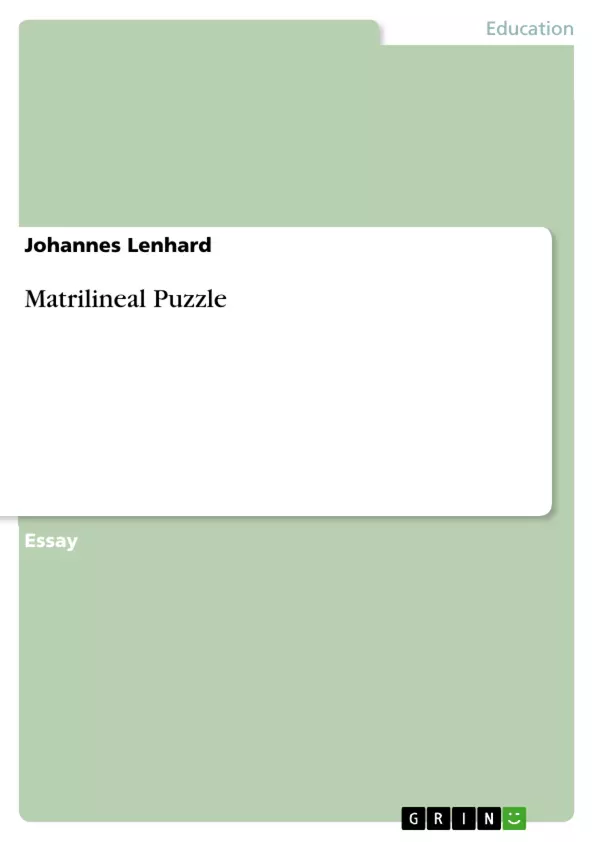The term ‘matrilineal puzzle’ was coined by Richards (Richards, 1950) and treated in a variety of both theoretical and ethnographic studies (e.g. Fuller, 1976; Gough & Schneider, 1961; Needham, 1971; Weiner, 1988). Essentially, the ‘puzzle’ is better described as a conflict arising from the general design of matrilineages: being based on both a principle of female descent and masculine control, a matrilineage generates a direct competition between in-marrying husbands/fathers and maternal brothers. Where is the family to live? Who has authority over the children? As Gough and Schneider (1961:29) claim, the matrilineal group is very unlikely to persist if the husband gains to much authority over wife and children. Several solutions to this dilemma can be found in the literature as well as in ethnographic studies four of which I focus upon in the following. Let me, however, introduce the underlying concepts in the introductory paragraph.
Table of Contents
- The Matrilineal Puzzle
- Four Solutions to the Matrilineal Puzzle
- Natolocal Residence
- Matrilocal Residence
- Avuncolocal Residence
- Dispersed Lineage
- The Relevance of the Matrilineal Puzzle Today
Objectives and Key Themes
This essay explores the concept of the "matrilineal puzzle" as coined by Richards, examining the complexities and conflicts that arise from matrilineal descent systems. The essay analyzes four theoretical solutions to this puzzle, drawing on ethnographic examples to illustrate the practical implications of these solutions.
- The "matrilineal puzzle" and its inherent conflict between male authority and female descent.
- Four theoretical solutions to the puzzle, including natolocal, matrilocal, avuncolocal, and dispersed lineage models.
- Ethnographic examples illustrating the application and limitations of the theoretical solutions.
- The potential for Western bias in anthropological studies of matrilineages.
- The continued relevance of the matrilineal puzzle in contemporary society.
Chapter Summaries
The essay begins by introducing the "matrilineal puzzle" as a conflict arising from the combination of female descent and male authority within matrilineages. It then presents four theoretical solutions: natolocal residence, where husbands are only sexual companions and do not reside with the women; matrilocal residence, where husbands live with their wives in their lineage; avuncolocal residence, where women reside with their husbands, but children later return to their matrilineage; and dispersed lineage, where formal rules are often less rigid.
Each solution is discussed in detail, with ethnographic examples illustrating the practical application of the theoretical models. The essay examines the case of the Nayars in India, where natolocal residence and a strong emphasis on the taravad (matrilineal joint family) initially prevailed, but later evolved towards a more patrilineal system. It also considers the Yao in Africa, where the "borrowed husband" solution is prevalent, with the uncle (mother's brother) holding significant authority over the children.
The Trobrianders of Melanesia are presented as an example of avuncolocal residence, where children are formally linked to both their father and their mother's lineage through various rituals and gift-giving practices. Lastly, the Kongo and the Ila are discussed as examples of dispersed lineage, where patrilocal residence prevails and matrilineal ties often take on a more ritualistic role.
Keywords
The essay revolves around the concept of matrilineage and the "matrilineal puzzle," which highlights the inherent conflict between female descent and male authority. The text delves into four theoretical solutions to this puzzle – natolocal, matrilocal, avuncolocal, and dispersed lineage – and explores the application of these solutions within specific ethnographic contexts, highlighting the influence of factors such as economic change, social structures, and cultural practices.
- Arbeit zitieren
- Johannes Lenhard (Autor:in), 2012, Matrilineal Puzzle, München, GRIN Verlag, https://www.grin.com/document/205562



